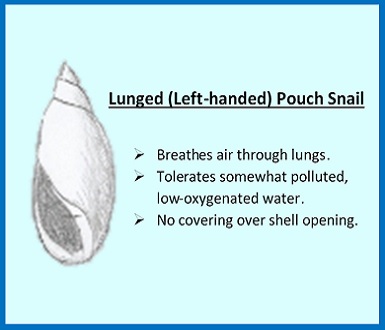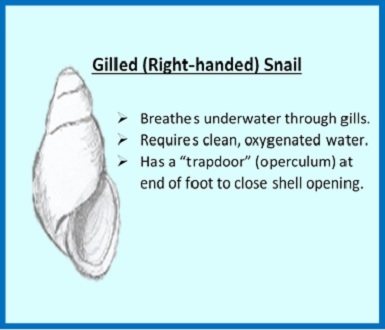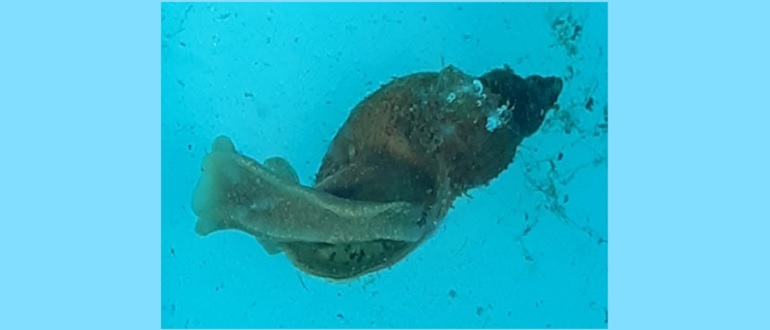Gilled freshwater snail swims in Rouge watershed. – photo by FOTR
A Tale of Two Snails
GET TO KNOW Freshwater Snails
The Rouge watershed is home to two different groups of freshwater snails – those with lungs and those with gills.
FUN FACT Snails are in the taxonomic class Gastropoda. However, there are many more different species of snails than most other creatures. This is because snails adapt rather quickly to their specific micro-environments and evolve rapidly into separate (non-mating) species. These differences may even occur between separate ponds / lakes within the same geographic area. As a result, the official taxonomic identification and naming of individual snails is ever changing and quite confusing.
Lunged snails (subclass: Pulmonata) rise to the surface and breathe air through a “pouch” membrane that acts as a lung in their shells. They are also known as pouch snails and are identified as “left-handed’ snails because their shell opening points to the left when held with the tip up. Since lunged snails breathe and store air, they are somewhat tolerant of environments with poor water quality.
Gilled snails (subclass: Prosobranchia) are identified as “right-handed” snails because the opening of the shell points to the right when held with the tip pointing up. As indicated by the name, these snails have gills and breathe underwater. Consequently, they require clean and well-oxygenated water to live.
Gilled snails also have a sort of trapdoor, known as an operculum, that can close off the shell opening. When the snail is in danger from a predator or gets stranded outside the water, it can fully retract into its shell and close its door to the world. This provides the snail some protection and allows it to survive short periods without water.


Michigan freshwater snails range in shell size from about 1/4 of an inch up to 1 1/2 inches. (Most are under 1 inch.) The soft body of the snail stays within the protective shell. Only the head and “foot” protrude from the shell. (The operculum of a gilled snail is part of the foot.) On the head, two eye stalks have tiny little eyes at the tips that allow the snail to see light and shadows underwater.
Snails use their muscular foot appendage to pull themselves forward. They glide slowly on a secreted layer of mucous designed to provide traction and to smooth out surfaces. Instead of a red carpet, each snail has its own personal little slime carpet to travel along!
Algae is the primary ingredient of a freshwater snail’s diet. They have a raspy sort of tongue (known as a radula) that they scrape along surfaces to shave off tiny bits of algae and other matter.
HABITAT & LIFE CYCLE
Lunged (pouch) snails are hermaphroditic. This means each individual snail has both male and female qualities. When a pair of lunged snails mate, both individuals are fertilized, and both lay a gelatinous egg mass (up to 50 eggs) in the water. Lunged snails generally live only about one year, but each individual may lay numerous clutches of eggs during that time.
Conversely, gilled snails may live 2 – 3 years and generally have separate male and female individuals. The mechanics of egg laying and hatching vary by species. Most often, the female lays egg clutches on underwater surfaces, but in some cases, eggs actually hatch within a special sac inside the female. In such cases, up to a dozen very tiny snails may grow a bit inside this special sac before making their way out into the world.
Newly hatched baby snails of all species are fully formed but very, very tiny. In some cases, they may be as small as 1/100th of an inch in shell length. Baby snails grow very quickly in proper water conditions.
Freshwater snails must extract dissolved calcium from their watery homes in order to maintain shell strength. Since the Rouge River watershed has limestone based soils, dissolved calcium has not been a limiting factor for the health of our little snail friends. Proper levels of dissolved calcium result in a water pH factor that is slightly basic (above 7.0). Every year, FOTR works with schools across the watershed (during the Rouge Education Project) to monitor physical, chemical, and biological metrics of stream / river health. One of these metrics is pH level. Long-term FOTR measurements indicate a median (and safe) pH factor between 7 and 8.
Some scientific studies indicate that acid rain can slowly neutralize dissolved calcium and lower pH levels in waterways. This has been an area of concern in some areas. Fortunately, Michigan’s limestone bedrock tends to offset the local effects of acid rain. FOTR will continue to monitor pH, and other metrics, to help Rouge River communities protect the health of the watershed.
TAKE ACTION
As previously noted, the types of snails found within the Rouge watershed have very different water quality requirements. Each spring and fall, FOTR conducts Bug Hunts to count samples of aquatic bugs at different sites within the watershed. Overall water quality is evaluated based on the types of creatures found at each site. Since lunged pouch snails are more tolerant of poor water clarity and low oxygen levels, their presence indicates that a stream is maintaining (at least) a minimal water quality for creatures. However, gilled snails are very sensitive to water quality and oxygen levels. Their presence indicates a better overall water quality.
You can get involved and volunteer with FOTR’s Spring and Fall Bug Hunts! For more information, please see: https://therouge.org/bug-hunts/
